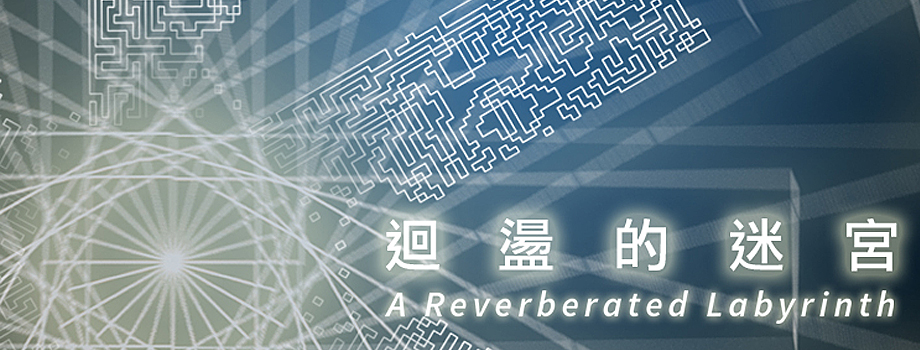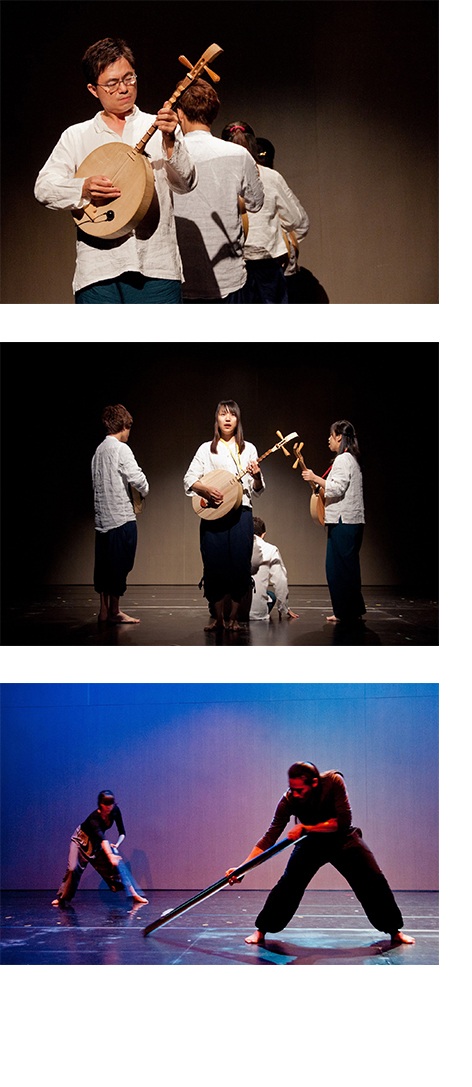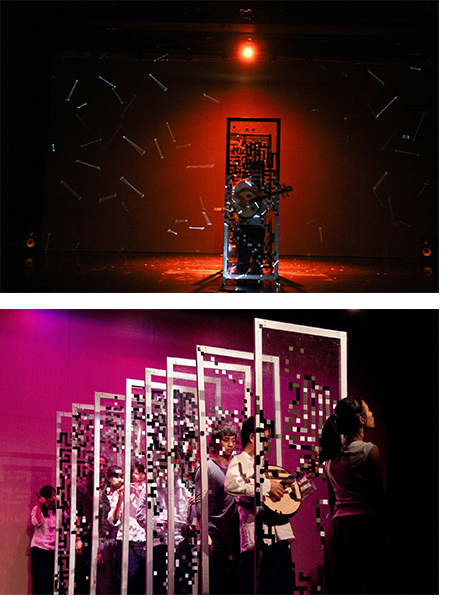2012 The Reverberant Labyrinth 「迴盪的迷宮」│國立交通大學跨領域藝術團隊
以前述的精神為創作的底蘊,從台灣的說唱文化為起點,結合傳統樂器月琴、二胡和四塊,並與現代音樂創作結合,以台灣原住民搗米的傳統與中南美洲原住民用來祈雨用的雨笙(俗稱雨棍)為靈感的啟發,進行筒柱新樂器的製作,利用聲音回授的原理進行聲音與肢體的創作表演,並藉由摩天輪影像重疊旋轉和開展的過程,逐步串連起聲音迷宮、視覺迷宮、生命迷宮的概念與作品的架構,並結合建築、裝置、肢體、聲音、視覺與數位藝術的科技藝術表演,與各種媒材形式環環相扣,讓時間與空間交叉折疊、快轉或凝滯,讓對生命的表達與回應能迴盪於其中。
在作品劇本編排上,團隊打破了時間與空間的疆界與線性的發展,走在古老與科技的交縫間,走在內心與外在的臨界上,利用蒙太奇拼貼手法-跳躍、切割、拼貼與重組,訴說著《迴盪的迷宮》的主題。在迷宮中,每一個死角,都是起點與終點,與其汲汲尋找,不如緩緩而安,享受生命萬象的樂趣,藉此展現生命的本質與歷程。作品以跨領域的合作方式,追求藝術的自由精神,回歸到藝術的最源頭 – 對生命的感動和體悟。
The Concept of “The Reverberant Labyrinth”
The Reverberant Labyrinth reflects a creative heritage. This begins with Taiwan’s talking and singing arts, then continues with combining traditional yueqin, erhu, and sikuai instruments with modern compositions. Inspiration is also derived from the rice pounding traditions of Taiwan’s Aboriginal people and the rainsticks used by indigenous people in Central and South America to bring rainstorms. When producing the column instrument, the principle of sound feedback was used to generate a creative performance based on sound and the body. Finally, an overlaid image of a gradually opening rotating wheel links the concepts of a sound labyrinth, visual labyrinth, and life labyrinth into the creative framework. Its theater stage performance brings together many elements including traditional Taiwanese chanting, sound installations, live electronic feedback, interactions of physical and virtual images, the combination of string and wind instruments with body performance, physical stage props, and digital images. With the appearance of a rotating maze, different media are linked in a chain, allowing an overlap between time and space. A fast rotation, or stagnation at one point, enables certain expressions and reflections of life to reverberate.
In the script and choreography, TransArt NCTU transcends the boundaries of time and space and the development of a linear story, finding a space between the ancient and the technologically modern. Walking the boundary between the individual and the world outside, montage and collage techniques are used to express the theme of the Reverberant Labyrinth. In a labyrinth, in either real life or a performing work, each of the apparent dead ends marks a starting point and an end point. It reveals the essential nature and process of life and suggests taking things slowly and enjoying the many pleasures of life, rather than rushing after one thing and another. The work uses interdisciplinary cooperation in the pursuit of free artistic spirit. It takes us back to the original idea of life and is an expression of the sensations and understanding of life. For a generation immersed in technology, the work attempts to reflect the most fundamental human sense of belonging in this world – the labyrinth.
no images were found
│ 維也納場次日期:2012年11月16日(五) 19:30 地點:孟德爾頌廳Fanny – Mendelssohn – Saal 維也納音樂暨表演藝術大學 |
│ 政治大學場次日期:2012年11月2日(五) 19:30-20:45 地點:政大藝文中心視聽館 導聆15分鐘,演出內容約60分鐘│ 無中場休息 |
│ 交通大學場次日期:2012年12月13日(四)19:30 地點:交大演藝廳 |自由入場 |
 |作品簡介
|作品簡介
「迴盪的迷宮」是一個結合建築、裝置、肢體、聲音、視覺與數位藝術的科技藝術表演,以劇場形式所呈現的跨界舞台作品。結合傳統台灣唸唱、聲音裝置、現場回授電聲、實體虛擬影像互動、絲竹樂器與肢體的結合、實體舞台道具及數位視覺等不同的元素,迷宮的面貌自行更迭流轉,與各種媒材形式環環相扣,生命迴盪於其中。作品以跨領域的合作方式,追求藝術的自由精神,回歸到藝術的最源頭-對生命的感動和體悟。
本作品以可拆組並可作為發聲媒材的單元體作為架構作品的起點,將空間動態化。結合舞臺燈光與黑光燈營造舞動的空間,傳達宇宙奧妙神祕的姿態和萬物生滅的景象。以光桌表演,加上深度攝影機之應用,將即時處理影像投射在固定的框架結構中來捕捉生命回憶點滴,呈現人類內心世界的枷鎖和徘徊。結合傳統樂器演奏和電腦即時收音變形處理來呼應無形的空間,劇情也將以不同的舞臺空間狀態來發展各種有形無形的迷宮。
交大多媒體藝術團隊近年國際展演的成果豐碩,2012年受到維也納音樂暨表演藝術大學 (Universität für Musik und darstellende Kunst Wien) 的邀請進行交流計畫。計畫內容以多媒體跨領域展演交流為主,並舉辦工作坊及相關跨領域藝術議題的學術交流。交大團隊將於2012年11月11~18日赴維也納,並於11月16日公開演出,地點在維也納音樂暨表演藝術大學“Fanny – Mendelssohn – Saal”孟德爾頌廳。維也納音樂暨表演藝術大學多媒體藝術團隊也將於2013年4月7日到 4月15日期間,來交大開設工作坊,並於交大演藝廳公開演出,互相交流觀摩跨領域藝術創作的美學經驗及技術與理論的應用。
|團隊簡介
交大跨領域藝術團隊(transArt NCTU)為應用藝術、音樂、建築三個研究所對跨領域創作感興趣的師生自發性組成的團隊,自2007年成軍後,分別於2008年至德國科隆市展出多媒體互動裝置、2009年舉辦兩場國際多媒體劇場工作坊、2010年展出建築音樂裝置,2011年應德國萊比錫市政府之邀發表多媒體互動劇場作品「回」。2012年跟歐洲知名的維也納音樂暨表演藝術大學進行藝術交流活動,將於今年11月於該校公演舞台作品「迴盪的迷宮」。
在台灣目前的外交處境下,交大跨領域藝術團隊近幾年來的國際藝術交流活動都是得來不易的成果,藉由展演的機會,讓國內外人士可以一窺交大在藝術創作上的努力,也對台灣在歐洲的聲譽有卓著的貢獻。該團隊希望能呈現台灣另一種正在發展中的藝術風格,亦希望能涵蓋傳統藝術之轉化應用,為現代數位科技藝術指出另一種可能性,讓未來的台灣跨領域藝術作品能尋求更廣闊的國際藝術表演舞台。
演出團隊|國立交通大學多媒體藝術團隊
藝術指導|董昭民、賴雯淑、侯君昊、謝啟民教授
肢體指導|徐昀芃
燈光設計|徐仲驊
參與團員|董昭民、賴雯淑、侯君昊、謝啟民、林怡秀、陳泓翰、吳昌祐、李宸安、鄭介瑤、許家茵、廖婉廷、陳宜惠、鄭乃銓
Act 1-聲音迷宮 The Sound Labyrinth
迴盪月琴 Reverberant Yueqin
採用台灣傳統唸唱的形式,以月琴為伴奏樂器,將流傳久遠的歌謠以疊唱的方式演出。在文本的延伸上, 為了達到迴盪的效果,將月琴加裝聲音震盪器 ( 無共鳴箱喇叭 ),並以 mp3 播放器將預錄的數位電子音效聲響及由唸唱改變的音樂片段,使得月琴成為會發聲的共振體,再配合現場即時的彈奏, 達到一種類比和數位、自然和人工的對話。在此基礎上,再配合演奏者的走位及樂器的位置改變,聲 音相位流轉變化,交疊起伏,聲音的迷宮就此形成。
Traditional Taiwanese chants accompanied by the yueqin (Chinese moon guitar) allow folksongs from the past to be used. In order to achieve a reverberation effect the yueqin is fitted with a resonance speaker and an MP3 player is used to play prerecorded electronic sounds and music with chanting. This transforms the yueqin into a resonator that produces sound, which, when united with live music performance, produces a dialogue between the digital, the natural and the artificial. When combined with changes in the position of the performers and the instruments, and changes in the movement of the sounds, including overlapping and undulating sounds, a sound labyrinth is created.
舞蹈鋼柱 Steel Dance Columns
台灣原住民使用木杵來舂搗小米,加工食物, 但也由此衍生出音樂舞蹈的形式,成為具有代表性的「杵歌」。為了延續 2011 年由建築所研發出來的舞台建築單元體,我們特別使用了外表相似, 但卻具有發聲功能的“木杵”來成為聲音迷宮的第二元素。木杵經由文本的延伸,成為與月琴對立, 象徵現代人對高科技盲目崇拜的“鋼柱”。我們將塑膠材質加工設計,並貼上金色的反光面紙, 成為外表冷酷堅硬的鋼柱。每根鋼柱因為長度的不同使得所通過的氣流產生不同的微弱音高。我們在鋼柱中加裝無線麥克風收錄此音高,利用擴音喇叭的聲音能量放大,使得麥克風與擴音喇叭之間形成回授系統,產生現場的回授效果,並經由電腦即時處理,營造了聽覺的多層次聲響迷宮。而鋼柱的位置會直接影響回授效果的產生與消逝,所以在視覺上,又可以肢體舞蹈的角度來設計演出者的走位和肢體動作,產生聽覺和視覺的雙重迷宮型態!
Taiwan’s Aboriginals use pestles to pound millet and process food. From this, a form of music and dance emerged, which became the well known “pestle song.” Extending an individual stage construction devised in 2011, TransArt NCTU uses an object with a similar appearance to the pestle that emit sounds as a second element of the sound labyrinth. Through extension of the text, the pestle is contrasted with the yueqin, symbolizing the blind worship of steel columns in modern society. Plastic material covered with silver reflective glossy paper is used to give the appearance of cold hard steel columns. The different length of the steel columns causes slight differences in the low-level pitch. A wireless microphone is fitted to the steel column to record this pitch, which is then amplified using loudspeakers. This creates a feedback system between the microphone and loudspeakers, creating a live feedback effect. Using real-time computer processing, a multi-layered auditory labyrinth was created. The position of the steel columns directly affects the appearance and disappearance of the feedback effect. Finally, in terms of visual perception, the design of the direction in the movements of the body performance is used to create a combined auditory and visual labyrinth.
Act 2-視覺迷宮 The Visual Labyrinth
摩天輪部分表演,是由 Kinect 深度攝影機、投影設備加上影像互動程式 Quartz Composer 共同完成。 Kinect 深度攝影機利用紅外線雷射,以大約 30 度角的範圍,向外打出一人眼不可見的紅外線雷射矩陣,並利用紅外線攝影機拍攝這些雷射產生的光點。紅外線雷射矩陣在空間上因為距離發射點的距離、角度不同,將產生不一樣大小,形狀的光點,Kinect 攝影機收集這些光點,經過內部演算後轉換成一 640X480 pixel 的灰階影像,在各個灰階影像中,距離較近的物體呈現近白色,而遠方的物體則接近黑色。
利用深度資訊的灰階影像,我們使用 MacOSX 平台上,以圖像思維撰寫程式的工具 QuartzComposer, 以 OpenCL 語言將灰階影像做曲線處理,套用加強變化量的曲線,並設定某兩個亮度之間的輸出,完成一套可以單獨拍攝某個距離之內物件的深度攝影系統。經過以上的處理所建立的深度系統,將可以在舞台上畫出一「深度」表演區。接著利用這套系統產生的影像,我們繼續在 Quartz Composer 內製作一支影像切割、重新組合的程式。
The rotating wheel performance is connected with a Kinect depth camera, projection equipment and a Quartz Composer, which last is a kind of interactive software on the MacOSX platform. The Kinect depth camera uses an infrared laser covering an approximately 30 degree range to emit an infrared laser array invisible to the human eye, while an infrared camera is used to photograph the laser spots. Variation in distance from the point of emission and the angle of emission produces changes in the size of the infrared laser array and shape of the laser spot. The Kinect camera gathers these laser points, which are then converted into 640X480 pixel grayscale images through an internal algorithm. In each of the grayscale images, closer objects appear nearer to white in color, while distant objects appear nearer to black.
With the help of the OpenCL language provided by Quartz Composer software, grayscale images can be modified, filtered and shifted in order to select specific depth information. For example, the upper and lower thresholds of grayscale depth in an image can be discarded to refine photographs of objects within certain depth ranges. After establishing a depth photography system using this method, a “deep” performance area was created on the stage. This system is used to create images, and to carry out image segmentation and image reconstruction using Quartz Composer software.
透過第一套深度系統與第二套影像切割系統,我們將舞台空間切成五組獨立的立方體空間,並將之轉 化為數個摩天輪框架,經過投影機再現於舞台天幕上,成為隱陷在既存空間中的數位變幻虛擬空間。 並藉由兩套系統的合作,在這五個空間取得表演者的肢體詮釋動作,加以各種視覺效果,重新存放於 虛擬空間中,因而賦予此空間新的生命,更因此成為耐人尋味的視覺迷宮。另透過深度攝影系統和影 像切割系統處理的畫面,其位置、大小、方向,分別由五個時間軸控制,表演過程中的動作是改變五 個畫面時間軸的觸發點。
Using both the depth and image segmentation systems, the stage is divided into five separate three- dimensional spaces, which make up the frame of the rotating wheel. Reproduced on the wall of the stage using a projector, the image transforms itself into a rotating virtual space hidden within the existing space of the stage. The two systems work together to present the performers’ physical interpretation in the five spaces. A variety of visual effects are added, and the performance is stored in the virtual space. This gives the space new life and definition, becoming a thought provoking rotating visual labyrinth. The depth photography system and image segmentation system are used to process the images, and the position, size, and direction of the images are controlled across five time intervals, while the performance action changes the trigger point for the five images.
在光桌影像即時互動故事的部分,大體是承襲去年的技術,但是配合整個舞台作品的呈現,故事文本做了全新的改寫,加入充滿台灣早期回憶的畫外音,例如小學的下課鐘聲、二次戰後的台語歌曲、夏日午後的蟬鳴聲,在遊戲人間的摩天輪迷宮之後,非常獨特地呈現了另一段道地台灣味的兒時回憶。
The use of the real-time interactive images from the light box to tell stories is borrowed primarily from a technical setup created previously. However, the text of the story was rewritten for the new production, with a voiceover of memories from Taiwan’s past added, including the sound of an elementary school end of class bell, Taiwanese songs after WWII, and the afternoon sound of cicadas. Aside from the rotating wheel labyrinth, these sounds provide a unique set of memories of childhood in Taiwan.
Act 3-生命迷宮 The Labyrinth Of Life
忘憂鼓影音互動技術配置 Lotus drum audio and visual interaction technical configuration
利用 Processing 程式的撰寫,讓影像呈現可以與忘憂鼓的聲音互動,在歷經虛擬摩天輪框架及作品中實體摺疊的框架之後,動態視覺呈現的是一大群旋轉的棒狀物,有如框架的碎片,隨著實體框架的離開,虛擬碎片陸續出現並填補舞台空白,碎片時而紛亂、時而群聚,宛如一種生命型態,並與現場演 奏的忘憂鼓即時對話。之後經摺碎片隨著三股上升力量形成柱狀螺旋,轉化成樹,解離又聚合,最後 如雪花般飄落,回歸舞台上的三個光點。最後隨著音樂消逝,回歸到生命原點。上述的影像變化除了 忘憂鼓即時收音互動外,還有一些參數可以透過 KORG nanoKONTROL 現場控制,包括切換段落及細 膩的影像變化。
After the visual labyrinth, the biokinetics image projects a swarm of rotating rods as artificial living beings interacting with the lotus drum. As the physical folding frames leave the stage, the virtual fragments appear, filling up the blank space on the stage. Just like a life form, the fragments sometimes appear chaotic, sometimes clustering together, creating a real-time dialogue with the lotus drum. Next, three waves of upward force propel the debris into a column formation (which transforms into a tree), disintegrating and rejoining, before finally falling like snow onto the stage. The fragments gradually reduce in number, before disappearing with the music, marking a return to the beginning of life. The biokinetics image projection was written in the software called Processing. Aside from interacting with the sound of the lotus drum, most parameters were controlled live using KORG nanoKONTROL, including transitions, effects and the precise movements of the fragments.

主辦單位|國立交通大學暨交大頂尖計畫辦公室、維也納音樂暨表演藝術大學、交大藝文中心、政大藝文中心
指導單位|文化部
諮詢電話|政大藝文中心(02)2939-3091 ext. 63393, nccuarts@nccu.edu.tw;交大藝文中心 03-5731953, ljwang@mail.nctu.edu.tw
交大跨領域藝術團隊|http://www.iaa.nctu.edu.tw/transart/




